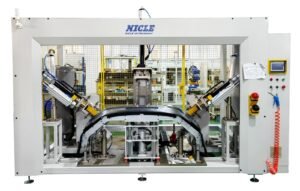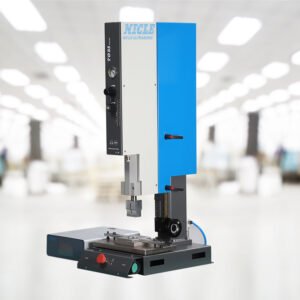In the rapidly advancing tide of modern industry, the automotive sector consistently plays a pivotal role. It’s not just a significant economic engine but also a culmination of technological innovation and aesthetic design. As consumers increasingly demand higher performance, safety, comfort, and personalization from their vehicles, the design and manufacturing processes for automotive interior and exterior trim components face unprecedented challenges and opportunities. Among the many advanced joining technologies, горячая сварка пластин stands out with its unique advantages, quietly transforming the production landscape of automotive trim and injecting strong momentum into the automotive industry’s pursuit of lightweighting, intelligence, safety, and aesthetic appeal.
I. Automotive Interior and Exterior Trim: A Perfect Blend of Industrial Aesthetics and Functional Utility
A car is no longer merely a means of transportation; it’s an extension of a lifestyle, a statement of taste. And the interior and exterior trim components are the core elements that embody these values.
Exterior Trim: Sculpting Streamlined Beauty, Showcasing Brand Charm
Automotive exterior trim creates a consumer’s first impression of a vehicle. From the fluid body lines and exquisite grille designs to the practical front and rear bumpers, elegant side skirts, roof racks, wheel arches, door handles, and rearview mirror housings—each component reflects the designer’s meticulous craftsmanship. These parts must not only exhibit excellent aerodynamic performance to reduce drag and improve fuel efficiency but also withstand harsh external environmental conditions, such as UV radiation, rain and snow erosion, impacts from sand and gravel during high-speed driving, and minor scratches from everyday parking. Moreover, they directly impact the vehicle’s overall aesthetics and brand recognition. The choice of materials, surface treatment, and joining methods all directly influence the quality and lifespan of exterior trim.
Interior Trim: Crafting the Driving Space, Enhancing Comfort and Safety
Stepping inside a car, the interior trim builds a private and comfortable driving space. The instrument panel, door panels, center console, seat frames, storage compartments, air vents, airbag modules, and even steering wheel frames—these components must possess both excellent tactile and visual appeal, and meet stringent functional and safety requirements. For instance, instrument panels and door panels need to integrate complex electronic components and wiring harnesses; seat frames must ensure seating comfort and support during collisions; and airbag modules require precise and rapid deployment in emergencies to protect occupants. Furthermore, with the development of automotive intelligence and connectivity, interior trim needs to better accommodate and integrate various human-machine interfaces, display screens, and smart sensors, also placing higher demands on material electromagnetic compatibility and acoustic performance.
Whether it’s exterior or interior trim, their production relies on efficient and reliable joining technologies. Traditional methods like screw fastening, clip connections, and adhesive bonding have their advantages in specific scenarios, but when faced with complex curved surfaces, high strength requirements, sealing needs, and the trend toward automated production, they often reveal limitations such as low efficiency, insufficient strength, poor sealing, and high costs. Hot plate welding technology, against this backdrop, demonstrates its unparalleled superiority.
II. Hot Plate Welding Machines: The “Magic Furnace” of Modern Automotive Manufacturing
Горячая сварка пластин, also known as hot platen welding or butt welding, is a process that uses a heated plate (or hot plate) to melt the contact surfaces of plastic components. The heated plate is then quickly removed, and the two softened surfaces are brought into rapid contact and pressed together to cool and fuse into a single piece. While its working principle appears simple, it involves precise control over parameters such as temperature, pressure, and time to ensure optimal weld quality.
Key Advantages of Hot Plate Welding Machines:
- Exceptional Weld Strength and Sealing: Hot plate welding achieves a true molecular fusion between similar or identical plastic materials, forming continuous and dense weld seams. This molecular-level bond often results in weld strength that equals or even surpasses the strength of the parent material, offering excellent airtightness and watertightness. This is an irreplaceable advantage for automotive interior and exterior components that demand strict sealing, such as fuel tanks, reservoirs, intake manifolds, HVAC ducts, and fluid reservoirs.
- Wide Material Applicability: Hot plate welding technology is suitable for almost all thermoplastics, including polypropylene (PP), polyethylene (PE), polycarbonate (PC), polyamide (PA/Nylon), ABS, PMMA, PBT, and more. These are the predominant materials used in automotive interior and exterior trim manufacturing.
- High Efficiency and Automation Potential: Modern hot plate welding machines typically employ PLC control, enabling fully automated operation. By precisely controlling parameters such as heating temperature, heating time, melt depth, hold time, and cooling time, production efficiency can be significantly improved, labor costs reduced, and consistent product quality ensured.
- Adaptability to Complex Shapes: The heating plate in hot plate welding can be customized to the shape of the parts to be welded, whether straight, curved, circular, or irregular, achieving perfect welds. This makes hot plate welding machines highly versatile in processing various complex three-dimensional structural components in automotive interior and exterior trim.
- Environmental Friendliness and Energy Efficiency: The hot plate welding process does not use any solvents, adhesives, or fillers, reducing chemical pollution and aligning with environmental trends. Furthermore, its energy utilization efficiency is relatively high, contributing to lower production energy consumption.
- Aesthetically Pleasing Welds, Minimal Post-Processing: Compared to some mechanical joining methods that might leave visible marks, hot plate welds are usually flat and consistent in color with the parent material, requiring little to no subsequent finishing, which enhances the overall aesthetics of the product.
- Cost-Effectiveness: While initial equipment investment might be relatively high, in the long run, due to its high efficiency, low reject rate, reduced post-processing steps, and superior product performance, hot plate welding can significantly lower the overall cost per unit.
III. Innovative Applications of Hot Plate Welding Machines in Automotive Interior and Exterior Trim
Thanks to the aforementioned advantages, hot plate welding technology has gained increasingly widespread application in the production of automotive interior and exterior trim, covering virtually every aspect from the engine bay to the passenger compartment:
1. Precision Joining of Automotive Exterior Trim:
- Bumpers: Automotive front and rear bumpers are often assembled from multiple plastic parts. Hot plate welding ensures strong connections, effectively absorbing impact forces during collisions, and maintaining a good overall appearance.
- Spoilers/Wings: These components demand high aerodynamic performance and structural integrity. Hot plate welding provides seamless connections, guaranteeing stability at high speeds.
- Headlamp Assemblies: The sealing of headlamp housings and lenses is crucial to prevent water vapor and dust from entering and affecting illumination. Hot plate welding provides reliable waterproof seals, ensuring long-term headlamp performance.
- Door Handles, Rearview Mirror Housings: These components are often made of two or more plastic parts. Hot plate welding achieves tight internal structural bonds, improving strength and aesthetics.
- Wheel Arches, Side Skirts: Besides their decorative function, these parts also protect the vehicle body and reduce splashing. Hot plate welding ensures their secure installation and resistance to external impacts.

2. Structural and Functional Integration of Automotive Interior Trim:
- Instrument Panel Assemblies: Complex internal structures of instrument panels, such as ventilation ducts, wiring harness brackets, and various mounting bases, are precisely integrated through hot plate welding, enhancing structural stability and simplifying assembly.
- Door Panel Linings: Storage compartments, armrests, speaker brackets, etc., on door panels can be joined with the main panel through hot plate welding, forming an integrated structure that reduces rattles and improves overall quality.
- Center Consoles and Storage Compartments: These functional components typically contain multiple compartments and internal support structures. Hot plate welding ensures their robust connection, facilitating the integration of various electronic modules and wiring harnesses.
- HVAC Vents: Precise HVAC vent structural components achieve sealed airflow and fixed components through hot plate welding, ensuring efficient airflow and accurate control of air direction.
- Seat Frames and Backrests: While main frames are often metal, many plastic components, such as seat pans, backrest panels, and rail covers, can be joined to metal frames or other plastic parts via hot plate welding, enabling lightweighting and functional integration.
- Airbag Modules: Airbag deployment mechanisms require extremely high reliability and sealing. Hot plate welding ensures the structural integrity of the airbag module for precise deployment at critical moments.
- Ventilation Ducts/Air Ducts: Automotive ventilation systems consist of complex plastic ducts. Hot plate welding provides leak-free connections, ensuring the efficiency and cleanliness of air circulation.
3. Integration of Automotive Functional Components:
- Engine Intake Manifolds: Complex internal flow paths demand extremely high sealing and airflow efficiency. Hot plate welding provides leak-free, low-resistance internal structures.
- Fuel Tanks/Reservoirs: In the production of automotive fuel tanks and coolant reservoirs, hot plate welding is a key process for achieving excellent sealing and corrosion resistance, ensuring no fluid leaks and enhancing driving safety.
- Battery Casings: Especially for the power battery packs of new energy vehicles, which require extremely high sealing, insulation, and structural strength, hot plate welding plays an irreplaceable role in such applications.
- Various Fluid Level Sensors, Pump Housings: Hot plate welding ensures the sealing of these fluid components, preventing leaks and functional failures.
IV. Future Outlook: The Intelligent and Green Path of Hot Plate Welding
As the automotive industry evolves towards intelligence, electrification, lightweighting, and shared mobility, hot plate welding technology will continue to innovate to meet the higher demands of future automotive manufacturing.
- Intelligent Integration and Data-Driven Management: Future hot plate welding machines will more deeply integrate sensors, machine vision, and artificial intelligence technologies to achieve real-time monitoring of the welding process, fault prediction, and adaptive adjustments. Through big data analysis, welding parameters will be optimized, improving production efficiency and product yield.
- Multi-Material Welding and Composite Material Applications: With the increasing demand for lightweighting in automobiles leading to more composite materials and dissimilar material joining needs, hot plate welding technology will explore combinations with other welding techniques like friction welding and laser welding to achieve more complex multi-material connections and broaden its application scope.
- Green Manufacturing and Circular Economy: Further optimize welding energy consumption and reduce waste generation. Simultaneously, considering the recycling and reuse of automotive components, the dismantlability and material separation convenience of hot plate welding will also become a focus in certain contexts.
- Miniaturization and Precision: For increasingly compact and precise electronic modules and sensor packaging within automobiles, hot plate welding technology will evolve towards finer and more miniaturized solutions to meet micro-joining requirements.
- Flexible Production and Customization: Facing growing consumer demand for personalization, automotive production lines need to be more flexible. Hot plate welding equipment will become easier to quickly switch molds and parameters, adapting to small-batch, multi-variety customized production models.
Заключение
Hot plate welding machines, as a shining star in modern plastic joining technology, are playing an indispensable role in the manufacturing of automotive interior and exterior trim components with their unique advantages. They not only enhance the strength, sealing, and aesthetic appeal of automotive parts but also contribute to the comprehensive upgrade of automotive lightweighting, safety, and comfort. From precise instrument panels to sturdy bumpers, from streamlined body attachments to complex internal ducts, hot plate welding technology acts as an invisible bond, fusing various independent components into a harmonious and unified whole, giving life and soul to automobiles.
Looking ahead, with continuous technological advancements and the transformation and upgrading of the automotive industry, hot plate welding technology will undoubtedly continue to deepen its application in automotive manufacturing, advancing towards a more intelligent, efficient, and environmentally friendly future, becoming a vital force in driving the high-quality development of the automotive industry. It is not just a machine; it is a smart furnace connecting the future and shaping dreams, jointly forging a glorious new chapter for the automotive industry.





